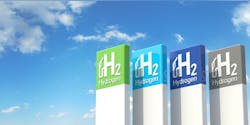Green, blue, or grey, hydrogen will not be the panacea to the United Kingdom (UK) meeting its 2050 net-zero targets, the country’s lawmakers have concluded.
Their comments come in “The Role of Hydrogen in Achieving Net Zero,” an 83-page report issued by the UK House of Commons Science and Technology Committee.
The 11-person committee, the majority of whom were drawn from the governing Conservative party, concluded multiple changes will be needed to the way the UK obtains, uses and stores energy if it is to reach net-zero emissions by 2050.
“Hydrogen will have its place in this portfolio. But we do not believe that it will be the panacea to our problems that might sometimes be inferred from the hopes placed on it. Essential questions remain to be answered as to how, in [the] future, large quantities of hydrogen can be produced, distributed, and used in ways that are compatible with net zero and cost efficiency,” they write.
The committee made its conclusions after hearing from 35 witnesses and receiving 98 written contributions.
An interesting difference of opinion occurred during the witness testimonies made by Nilay Shah, professor of process systems engineering and head of the department of chemical engineering at Imperial College London, and David Cebon, professor of mechanical engineering at the University of Cambridge. The committee chair asked both for a potted taxonomy of the different hues of hydrogen.
Shah explained that about 98% of the hydrogen currently made is grey — from reforming natural gas, oil or coal, but integration with carbon capture and storage will give access to blue hydrogen which can be made at scale and at a cost that could serve as industrial feedstock and industrial fuel, for example. Green hydrogen, from electrolysis, is already cost-competitive in some situations for the replacement of diesel in the transport industry, he added.
An interesting difference of opinion occurred during witness testimonies.
However, Cebon was keen to emphasize the Achilles heel of hydrogen processes: their inefficiency.
“It is the Heineken of the energy system: only use it in places that electrification cannot reach,” he emphasized. (Editor’s note: "Heineken refreshes the parts that other beers cannot reach" was one of the most successful ad campaigns in European history.) “It absolutely has to be used for making fertilizer. Most of the world’s hydrogen is used for ammonia fertilizer. We cannot do without that. That is essential to supporting the current population of the earth, so it has to stay. There are various industrial processes, such as making steel, where it is needed,” Cebon adds.
The thoughts of Shell, London, UK, and the Institution of Chemical Engineers (IChemE), Rugby, UK, are among the 98 written comments published in the report.
IChemE calls for hydrogen not to be considered in isolation, but through a systems approach — from generation to storage, transport, use and use of byproducts. Among the factors IChemE lays emphasis on are: compression and liquefaction of hydrogen are very energy-intensive processes; hydrogen fuel cells have limited overall efficiency and require high purity of hydrogen; and alternatives such as batteries face the challenges of charging and reduced efficiency.
Shell meanwhile urges greater policy and regulatory clarity from the UK government and to bring forward more significant and scalable prospects for the gas. The company notes this must happen soon, pointing out that other countries such as Australia and regions including the European Union (EU) already have published hydrogen strategies showing how they plan to unlock investments in all parts of the hydrogen value chain.
“In our view, a UK hydrogen strategy is also required rapidly, given the UK will likely be competing against other jurisdictions for innovation and deployment capital,” the company writes.
Shell emphasized that such a strategy should encompass both green and blue hydrogen; a twin-track approach would enable the UK to take advantage of its potential in both offshore wind, and carbon capture, utilization and storage. “Supporting both production methods could enable the UK to become, over time, a net exporter of hydrogen, including to EU markets, where there is likely to be a shortfall in indigenous production.”
Further, a market for tradeable guarantees of origin (GOs) would make it possible to compare the direct environmental impact of different types of molecules.
However, here’s the kicker: Involvement in such a market would require the UK to implement all or most of the EU Renewable Energy Directive into its own legislation and align with the EU on key principles for establishing a market design framework for hydrogen which supports the development of an integrated and competitive EU/UK market for hydrogen — prospects the current Conservative government would likely balk at for ideological reasons.
About the Author
Seán Ottewell
Editor-at-Large
Seán Crevan Ottewell is Chemical Processing's Editor-at-Large. Seán earned his bachelor's of science degree in biochemistry at the University of Warwick and his master's in radiation biochemistry at the University of London. He served as Science Officer with the UK Department of Environment’s Chernobyl Monitoring Unit’s Food Science Radiation Unit, London. His editorial background includes assistant editor, news editor and then editor of The Chemical Engineer, the Institution of Chemical Engineers’ twice monthly technical journal. Prior to joining Chemical Processing in 2012 he was editor of European Chemical Engineer, European Process Engineer, International Power Engineer, and European Laboratory Scientist, with Setform Limited, London.
He is based in East Mayo, Republic of Ireland, where he and his wife Suzi (a maths, biology and chemistry teacher) host guests from all over the world at their holiday cottage in East Mayo.

